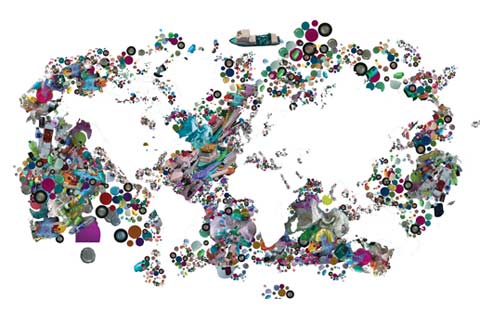Some lab animals get reprieve from testing
Updated: 2014-06-05 07:23
By Xu Wei (China Daily)
|
|||||||||||
 |
|
Researchers at the Institute for In Vitro Sciences in the United States conduct a phototoxicity test on cosmetic products using the in vitro methods. Provided to China Daily |
Alice Cai, director of Life Sciences at the Research and Development Center of the French cosmetics giant L'Oreal Group, said all the company's products are developed through alternative methods. "In fact, the data we collected through animal testing couldn't accurately project the effects on human beings, especially in terms of cosmetics," she said.
 |
| Tightening leash on testing on animals |
| Get beautiful without harming animals |
However, because some alternative testing procedures also require the use of animal tissue, an outright ban on the use of animals is still not a practical option.
For example, the Bovine Corneal Opacity and Permeability Assay, an alternative procedure to gauge eye irritation caused by cosmetics, requires the use of bovine corneas. Although the corneas are obtained from slaughterhouses, the method is still considered an improvement on in vivo testing, which can require the use of dozens of rabbits.
"Some test methods enable scientists to use a single animal's organs to yield a large number of research results, while others require the use of hundreds of live animals. That's the difference," Zhang said.
An inevitable shift
Animal rights groups have complained that tests on live animals are not only cruel and inhumane, but can also produce inaccurate results.
The Hygienic Standards for Cosmetics, China's official rules on safety tests for cosmetics, are based on guidelines drawn up by the Organization for Economic Cooperation and Development, which stipulate that all cosmetics products must be subjected to 17 animal-based toxicological tests, including those for acute oral toxicity, acute eye irritation, skin sensitization and a combined test for chronic toxicity and carcinogenicity.
The OECD guidelines, which include a range of alternative procedures, have opened the doors for the use of in vitro methods in recent years.
"Animals are animals and human beings are human beings. The results of tests conducted on animals do not necessarily reflect the effects of the products on human beings," said Zhang from the Institute for In Vitro Sciences in the United States.
Zhang used the example of eye irritation tests, traditionally conducted on rabbits, to explain his case. "The eye conjunctiva (the transparent tissue that covers the eye) of rabbits has only four to five layers, while human beings have 12 layers. How can you expect tests on rabbits to predict the results on human beings?" he said.
Some cosmetics companies said they have long been troubled by the use of live animals in tests. "We send the same batch of products to three test agencies under different government departments and the results are always drastically different, so we don't know which result to trust," said Chen Liang, nutrition and care science manager with Biostime Inc, a Guangdong-based cosmetics company.
Chen said the company has always taken great interest in in vitro procedures because they often provide new insights into products, and some alternative methods, including in vitro, have advantages over traditional tests, such as the shorter time needed to yield results.
"However, the biggest advantage lies in the fact that the cells used are developed to resemble human skin, and thus can give more accurate projections," he said.
Popularization
According to experts, the promotion of alternative testing methods in China will require the involvement of scientists, because many domestic laboratories and testing institutes are still unable to fully comprehend the strengths of in vitro methods and the benefits the companies would enjoy.
"Many experts still have no knowledge about alternative methods, or whether they are easy to conduct or not. The promotion of these methods must start with the popularization of the science involved," said L'Oreal's Cai.
Cheng said that only national-level legislation would fully motivate scientists to learn about alternative methods: "Currently, there is no law requiring the mandatory use of in vitro methods, but the development of the industry will need legislation."
Meanwhile, the popularization of 3R concepts - replacing and reducing the number of animals used in experiments, and refining the procedures to make them less harmful - continues to lag behind Western countries, many of which have adopted the concepts through legislation.
"There is a need for a national coordination mechanism to popularize alternative testing methods," Cheng said.
Cheng's department is China's leading research and test institute for the use of alternative testing methods within the cosmetics industry. It has hosted two workshops related to alternative testing procedures, and is attracting growing interest from manufacturers and test institutes.
Kang Hua, a researcher from the Zhejiang Institute for Food and Drug Control, said the institute has sent researchers to the US to be trained in the use of in vitro methods, and has also purchased the necessary equipment and built the facilities required for their implementation.
However, despite this recognition of the need to keep abreast of technological changes, the institute still faces a number of problems, she said.
"The source of tissue is a problem. For instance, one of the in vitro test methods requires the use of bovine corneas, but in certain places, Zhejiang province for instance, it's difficult to find fresh bovine corneas."
For Kang, though, the biggest obstacle to the promotion of alternative testing procedures lies in the lack of national coordination: "In China, in vitro methods are regarded as a form of research, and that means there are no compulsory regulations to oversee their use. Things won't change until legislation is enacted," she said.
Contact the author at: xuwei@chinadaily.com.cn
Related Stories
Get beautiful without harming animals 2014-04-02 08:38
Tightening leash on testing on animals 2014-04-15 02:01
Today's Top News
Obama meets central, eastern European leaders
Fighting rages on in east Ukraine
Egypt's Sisi declares president
BBC star Savile abuse 'reaches 500'
Director of JFK to make movie on Snowden
Brazil installs Chinese security systems for Cup
US to boost military in Europe
Spain's king abdicates to revive monarchy
Hot Topics
Lunar probe , China growth forecasts, Emission rules get tougher, China seen through 'colored lens', International board,
Editor's Picks

|

|

|

|

|

|






